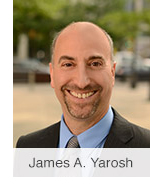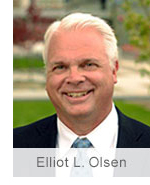|
Welcome to the Siegel Brill newsletter.
Knowing you and your businesses is our goal at Siegel Brill. There are always interesting things happening at our firm and people willing to share their knowledge; some of which just might benefit your business. We hope you enjoy our newsletter and getting to know us just a little better.
Jim Yarosh participates in case rejecting city development fee
 By Jim Yarosh By Jim Yarosh
Recently Jim Yarosh successfully represented developer Frank Kottschade, the National Association of Home Builders (NAHB) and the Builders Association of the Twin Cities (BATC), as amici curiae (friends of the court) at the Court of Appeals. On behalf of his clients, Yarosh urged the Court in his amicus brief to affirm the lower court’s decision invalidating a City of Woodbury imposed fee of nearly $1.4 million for future roads that were not included as part of a developer’s proposed subdivision.
In Harstad v. City of Woodbury, the Court of Appeals upheld the district court’s decision to invalidate the fee. The Court held that the city lacked the statutory authority—express and implied—to impose its “Major Roadway Assessment” as a condition of approving the developer’s subdivision application. In so doing, the Court rejected the city’s argument that it had explicit authority under a broad subdivision statute that allowed cities to condition approval on the installation of streets, utilities and other improvements. The Court, citing existing precedent, held that the statute authorized broad planning powers in requiring such improvements, but did not necessarily confer broad financing powers giving cities the ability to require developers to pay for them. The Court also rejected the city’s argument that a statute allowing cities to enter into development agreements permitted the city to contractually impose the fee on the developer.
CLICK TO READ MORE
Blake Shepard, Jr. has joined
Siegel Brill
 Blake Shepard focuses his practice on complex litigation matters, and has extensive experience in the areas of commercial litigation, product liability and personal injury litigation, and trust and estate litigation. Before joining Siegel Brill, Blake practiced for nearly 30 years as a partner in a large Minneapolis law firm, where he successfully represented Fortune 500 companies, privately held entities and individuals in a wide variety of product liability, trust, tort and commercial cases in state and federal courts throughout the country. Blake Shepard focuses his practice on complex litigation matters, and has extensive experience in the areas of commercial litigation, product liability and personal injury litigation, and trust and estate litigation. Before joining Siegel Brill, Blake practiced for nearly 30 years as a partner in a large Minneapolis law firm, where he successfully represented Fortune 500 companies, privately held entities and individuals in a wide variety of product liability, trust, tort and commercial cases in state and federal courts throughout the country.
Blake has served as national, regional and Minnesota counsel in individual, coordinated and class action product liability cases. His product liability experience includes representation of manufacturers in mass tort, wrongful death, catastrophic injury and commercial warranty cases; FDA and CPSC recall proceedings and post-recall litigation; workplace injury and construction accident cases; toxic exposure cases; and fraud, consumer protection and false advertising claims.
CLICK TO READ MORE
Anhydrous Ammonia: a Unique Type of Personal Injury Case
 By Elliot Olsen By Elliot Olsen
One of the things that makes the practice of personal injury law so interesting is all of the different niches and the unique circumstances of each. For years I have specialized in fairly well-known practice areas such as foodborne illness, Legionnaires’ disease, medical malpractice, and products liability. But I also handle cases dealing with anhydrous ammonia, which is not a well-known personal injury niche. Because so few attorneys take these cases, many people hear very little about anhydrous ammonia.
WHERE IT IS FOUND: Anhydrous ammonia usually comes from farming operations where it is used as a fertilizer. It is transported on highways in tankers or is often towed in smaller tanks known as nurse tanks. It is a substance that has to be kept under pressure to maintain a liquid form. That factor can lead to a release of the gas when it is not handled properly.
DANGER LEVEL: Anhydrous ammonia by definition does not contain water, so when it comes in contact with any bodily tissue that contains water, especially things like eyes, or the throat, or the lungs, it interacts with bodily tissues and causes burning and scarring. This happens immediately, on contact, and the injury worsens as time goes on.
CLICK TO READ MORE
|

